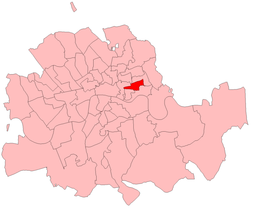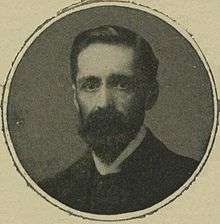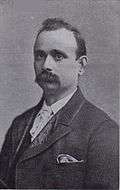Stepney (UK Parliament constituency)
| Stepney | |
|---|---|
|
Former Borough constituency for the House of Commons | |
| 1885–1918 | |
| Number of members | one |
| 1950–1974 | |
| Number of members | one |
| Replaced by | Stepney and Poplar |
| Created from | Limehouse, Mile End and Whitechapel and St George's |
Stepney was a parliamentary constituency centred on the Stepney district of the East End of London. It returned one Member of Parliament (MP) to the House of Commons of the Parliament of the United Kingdom, elected by the first past the post system.
History
The constituency existed for two separate periods:
- it was first created under the Redistribution of Seats Act 1885, for the 1885 general election, and abolished for the 1918 general election
- from the 1950 general election until its abolition for the February 1974 general election, when it was largely replaced by the new constituency of Stepney and Poplar.
Boundaries


The constituency was first created in 1885, as a division of the parliamentary borough of Tower Hamlets, centred on the Stepney neighbourhood in the East End of London. The area was administered as part of the Tower division of the county of Middlesex.
In 1889 there were administrative changes. The territory of the constituency was severed from Middlesex and included in the new County of London. The lower tier of local government in the area continued to be administered by parish vestries and local boards of works.
In 1900 local government in London was rationalised. The Stepney Board of Works was abolished and the civil parish of Stepney became part of a larger Metropolitan Borough of Stepney.
In the redistribution of parliamentary seats in 1918, the Metropolitan Borough was divided between three constituencies - Limehouse, Mile End and Whitechapel and St George's. The previous Stepney constituency was abolished and largely replaced by Whitechapel and St George's.
In the next major redistribution of parliamentary seats, which took effect for the United Kingdom general election, 1950, the Stepney constituency was re-created. The 1950 version of the seat comprised the whole of the Metropolitan Borough of Stepney.
In 1965 Stepney became part of the London Borough of Tower Hamlets and Greater London. When parliamentary constituencies were next redistributed, for the February 1974 general election, the area was included in the Stepney and Poplar seat.
Members of Parliament
MPs 1885–1918
| Election | Member | Party | |
|---|---|---|---|
| 1885 | John Charles Durant | Liberal | |
| 1886 | Frederick Wootton Isaacson | Conservative | |
| 1898 | William Charles Steadman | Liberal | |
| 1900 | William Evans-Gordon | Conservative | |
| 1907 | Frederick Leverton Harris | Conservative | |
| 1910 Dec. | William Samuel Glyn-Jones | Liberal | |
| 1918 | constituency abolished | ||
MPs 1950–1974
Constituency re-established 1950
| Election | Member | Party | |
|---|---|---|---|
| 1950 | Walter Edwards | Labour | |
| 1964 | Peter Shore | Labour | |
| Feb 1974 | constituency abolished | ||
Elections
Elections in the 1970s
| Party | Candidate | Votes | % | ± | |
|---|---|---|---|---|---|
| Labour | Peter David Shore | 18,993 | 74.8 | ||
| Conservative | Harry Greenway | 4,922 | 19.4 | ||
| Communist | Solly Kaye | 1,468 | 5.8 | ||
| Majority | 14,071 | 55.4 | |||
| Turnout | 44.9 | ||||
| Labour hold | Swing | ||||
Elections in the 1960s
| Party | Candidate | Votes | % | ± | |
|---|---|---|---|---|---|
| Labour | Peter David Shore | 23,098 | 76.1 | ||
| Conservative | Beryl Phyllis Cooper | 5,049 | 16.6 | ||
| Communist | Solly Kaye | 2,209 | 7.3 | ||
| Majority | 18,049 | 59.5 | |||
| Turnout | 50.7 | ||||
| Labour hold | Swing | ||||
| Party | Candidate | Votes | % | ± | |
|---|---|---|---|---|---|
| Labour | Peter David Shore | 22,184 | 71.4 | ||
| Conservative | I. F. H. Davison | 6,466 | 20.7 | ||
| Communist | Solly Kaye | 2,454 | 7.9 | ||
| Majority | 15,818 | 50.7 | |||
| Turnout | 51.3 | ||||
| Labour hold | Swing | ||||
Elections in the 1950s
| Party | Candidate | Votes | % | ± | |
|---|---|---|---|---|---|
| Labour | Walter James Edwards | 26,875 | 70.7 | ||
| Conservative | P. B. Calwell | 8,566 | 22.6 | ||
| Communist | Solly Kaye | 2,548 | 6.7 | ||
| Majority | 18,309 | 48.2 | |||
| Turnout | 59.4 | ||||
| Labour hold | Swing | ||||
| Party | Candidate | Votes | % | ± | |
|---|---|---|---|---|---|
| Labour | Walter James Edwards | 27,677 | 73.0 | ||
| Conservative | L. F. Sutton | 5,733 | 15.1 | ||
| Communist | Solly Kaye | 2,888 | 7.6 | ||
| Liberal | Fred Winckless | 1,615 | 4.3 | ||
| Majority | 21,944 | 57.9 | |||
| Turnout | 57.8 | ||||
| Labour hold | Swing | ||||
| Party | Candidate | Votes | % | ± | |
|---|---|---|---|---|---|
| Labour | Walter James Edwards | 35,849 | 76.5 | ||
| Conservative | M. H. B. Solomon | 7,586 | 16.2 | ||
| Communist | Edward F. Bramley | 3,436 | 7.3 | ||
| Majority | 28,263 | 60.3 | |||
| Turnout | 70.9 | ||||
| Labour hold | Swing | ||||
| Party | Candidate | Votes | % | ± | |
|---|---|---|---|---|---|
| Labour | Walter James Edwards | 33,475 | 70.0 | N/A | |
| Conservative | M. H. B. Solomon | 6,238 | 13.1 | N/A | |
| Communist | Philip Piratin | 5,991 | 12.5 | N/A | |
| Liberal | J. H. Maynard | 2,105 | 4.4 | N/A | |
| Majority | 27,237 | 57.0 | N/A | ||
| Turnout | 72.5 | N/A | |||
| Labour hold | Swing | N/A | |||
Elections in the 1910s

| Party | Candidate | Votes | % | ± | |
|---|---|---|---|---|---|
| Liberal | William Samuel Glyn-Jones | 1,926 | 51.5 | ||
| Conservative | Walter Reuben Preston | 1,812 | 48.5 | ||
| Majority | 114 | 3.0 | |||
| Turnout | |||||
| Liberal gain from Conservative | Swing | +4.5 | |||
| Party | Candidate | Votes | % | ± | |
|---|---|---|---|---|---|
| Conservative | Frederick Leverton Harris | 2,102 | 53.0 | ||
| Liberal | William Samuel Glyn-Jones | 1,861 | 47.0 | ||
| Majority | 241 | 6.0 | |||
| Turnout | |||||
| Conservative hold | Swing | -10.0 | |||
Elections in the 1900s
| Party | Candidate | Votes | % | ± | |
|---|---|---|---|---|---|
| Conservative | Frederick Leverton Harris | 2,299 | 63.0 | ||
| Lib-Lab | B. Cooper | 1,350 | 37.0 | ||
| Majority | 949 | 26.0 | |||
| Turnout | 5,621 | 64.9 | |||
| Conservative hold | Swing | +5.7 | |||
| Party | Candidate | Votes | % | ± | |
|---|---|---|---|---|---|
| Conservative | Sir William Eden Evans-Gordon | 2,490 | 57.3 | ||
| Liberal | Durham Stokes | 1,853 | 42.7 | ||
| Majority | 637 | 14.6 | |||
| Turnout | 5,176 | 83.9 | |||
| Conservative hold | Swing | -4.5 | |||
| Party | Candidate | Votes | % | ± | |
|---|---|---|---|---|---|
| Conservative | William Eden Evans-Gordon | 2,783 | 61.8 | ||
| Lib-Lab | William Charles Steadman | 1,718 | 38.2 | ||
| Majority | 1,065 | 23.6 | |||
| Turnout | 5,878 | 76.6 | |||
| Conservative gain from Lib-Lab | Swing | +12.0 | |||
Elections in the 1890s

| Party | Candidate | Votes | % | ± | |
|---|---|---|---|---|---|
| Lib-Lab | William Charles Steadman | 2,492 | 50.2 | ||
| Conservative | William Eden Evans-Gordon | 2,472 | 49.8 | ||
| Majority | 20 | 0.4 | |||
| Turnout | 6,387 | 77.7 | |||
| Lib-Lab gain from Conservative | Swing | +5.8 | |||

| Party | Candidate | Votes | % | ± | |
|---|---|---|---|---|---|
| Conservative | Frederick Wootton Isaacson | 2,346 | 55.6 | ||
| Liberal | W.H. Dickinson | 1,876 | 44.4 | ||
| Majority | 470 | 11.2 | |||
| Turnout | 6,048 | 69.8 | |||
| Conservative hold | Swing | +4.6 | |||
| Party | Candidate | Votes | % | ± | |
|---|---|---|---|---|---|
| Conservative | Frederick Wootton Isaacson | 2,292 | 51.0 | ||
| Liberal | B.T.L. Thomson | 2,203 | 49.0 | ||
| Majority | 89 | 2.0 | |||
| Turnout | 6,069 | 74.1 | |||
| Conservative hold | Swing | -5.3 | |||
Elections in the 1880s
| Party | Candidate | Votes | % | ± | |
|---|---|---|---|---|---|
| Conservative | Frederick Wootton Isaacson | 2,237 | 56.3 | ||
| Liberal | R.S. Wright | 1,735 | 43.7 | ||
| Majority | 502 | 12.6 | |||
| Turnout | 6,925 | 57.4 | |||
| Conservative gain from Liberal | Swing | +6.6 | |||
| Party | Candidate | Votes | % | ± | |
|---|---|---|---|---|---|
| Liberal | John Charles Durant | 2,141 | 50.3 | ||
| Conservative | Frederick Wootton Isaacson | 2,119 | 49.7 | ||
| Majority | 22 | 0.6 | |||
| Turnout | 6,925 | 61.5 | |||